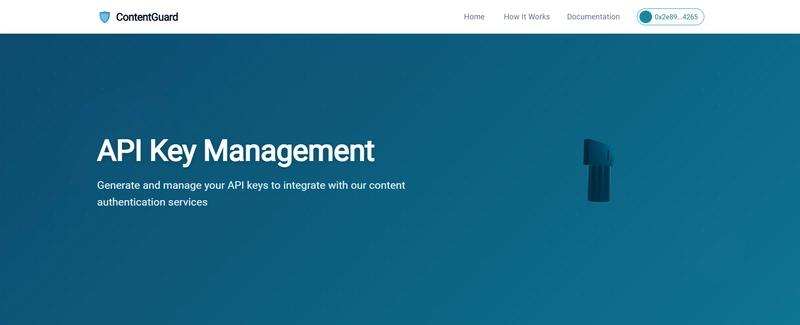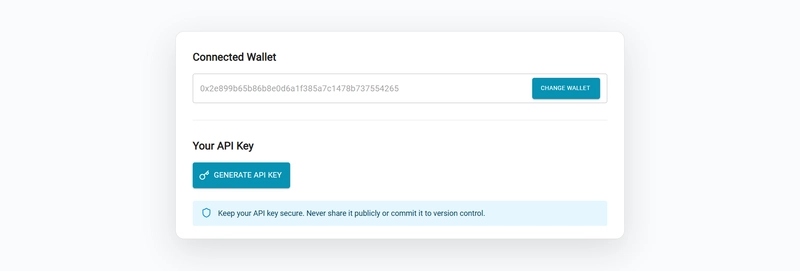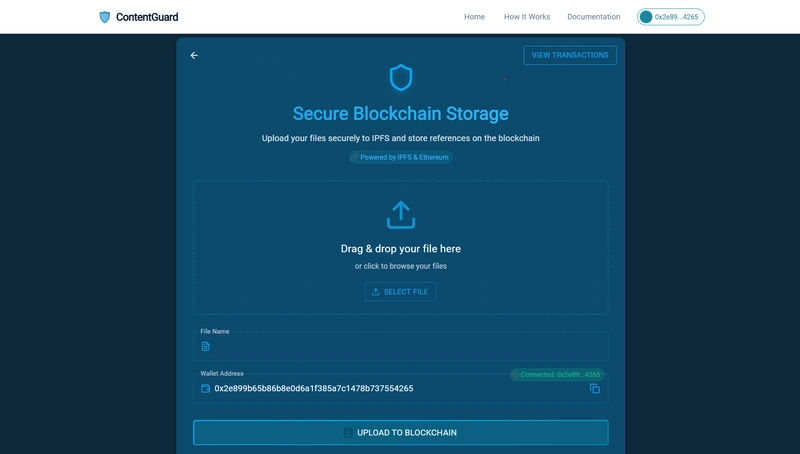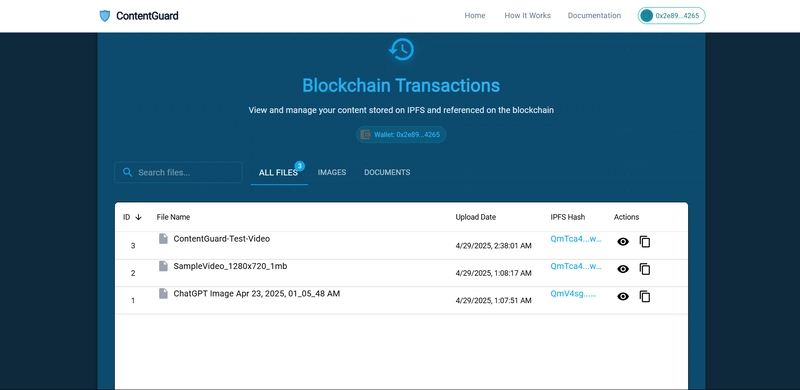Combating Deepfakes: Building a Decentralized Content Authentication System
Introduction: The Deepfake Dilemma In today's digital landscape, the line between authentic and synthetic content is increasingly blurred. Deepfakes and AI-generated media have evolved to a point where distinguishing between real and fabricated content has become nearly impossible for the average person. According to recent studies, deepfake videos online have increased by over 900% since 2019, and this trend shows no signs of slowing down. As developers and technologists, we face a critical challenge: how do we establish and maintain trust in digital content? How can we provide creators with the tools to prove ownership and authenticity of their work in an age of sophisticated AI manipulation? This is where the Content Authentication project comes in—a decentralized solution leveraging blockchain technology and distributed storage to establish an immutable record of content provenance. The Solution: Decentralized Content Authentication The Content Guard project offers a robust framework for verifying the authenticity of digital content by combining two powerful technologies: blockchain for immutable record-keeping and IPFS (InterPlanetary File System) for decentralized storage. At its core, the system works by: Storing original content on IPFS, generating a unique cryptographic hash Recording this hash on the blockchain along with creator information Providing verification tools that anyone can use to confirm content authenticity Unlike centralized authentication systems that rely on a single point of truth (and failure), this decentralized approach distributes trust across the network, making it resistant to tampering and censorship. Technical Architecture Let's dive into the technical components that make up the Content Authentication system: Frontend (React.js with Material-UI) The frontend provides an intuitive interface for content creators to authenticate their work and for users to verify content. Built with React and Material-UI, it offers: Wallet connection using Web3 providers like MetaMask File upload interface with drag-and-drop capabilities Dashboard to view authenticated content and transaction history Verification tools for checking content authenticity Key components from our frontend codebase include: // BlockchainFileUploader.jsx import React, { useState } from 'react'; import { useWeb3React } from '@web3-react/core'; import { uploadFileToIPFS, registerFileOnBlockchain } from '../utils/FileUtils'; const BlockchainFileUploader = () => { const { account, library } = useWeb3React(); const [uploadStatus, setUploadStatus] = useState('idle'); const handleFileUpload = async (file) => { try { setUploadStatus('uploading'); // Upload to IPFS const ipfsResult = await uploadFileToIPFS(file); // Register hash on blockchain const tx = await registerFileOnBlockchain( ipfsResult.hash, file.name, account, library.getSigner() ); setUploadStatus('success'); return { ipfsHash: ipfsResult.hash, txHash: tx.hash, }; } catch (error) { setUploadStatus('error'); console.error('Upload failed:', error); } }; // Component rendering code... } Backend (FastAPI with Python) Our backend API handles the bridge between the frontend, blockchain, and IPFS: @router.post("/upload") async def upload_file( file: UploadFile, file_name: str = Form(...), user_address: str = Form(...) ): """Upload a file to IPFS and store metadata in blockchain.""" try: user_address = Web3.to_checksum_address(user_address) result = await save_file_to_ipfs_and_blockchain(file, file_name, user_address) return JSONResponse(content=result) except Exception as e: logger.error(f"Error uploading file: {str(e)}") raise HTTPException(status_code=500, detail="An error occurred while uploading the file.") The backend implements several key services: IPFS Integration - Handling file storage and retrieval from the distributed file system Blockchain Interface - Communicating with Ethereum smart contracts Authentication Layer - Securing API endpoints with wallet-based verification Transaction Management - Tracking and recording content registration events Blockchain Layer (Ethereum/Solidity) The blockchain component provides the immutable ledger for content authentication records. Our Ethereum smart contract handles: // UserFileStorage.sol pragma solidity ^0.8.0; contract UserFileStorage { struct FileRecord { string ipfsHash; string fileName; uint256 timestamp; address owner; bool exists; } // Mapping from IPFS hash to file record mapping(string => FileRecord) private fileRecords; // Event emitted when a new file is registered event FileRegistered(string ipfsHash, string fileName, address
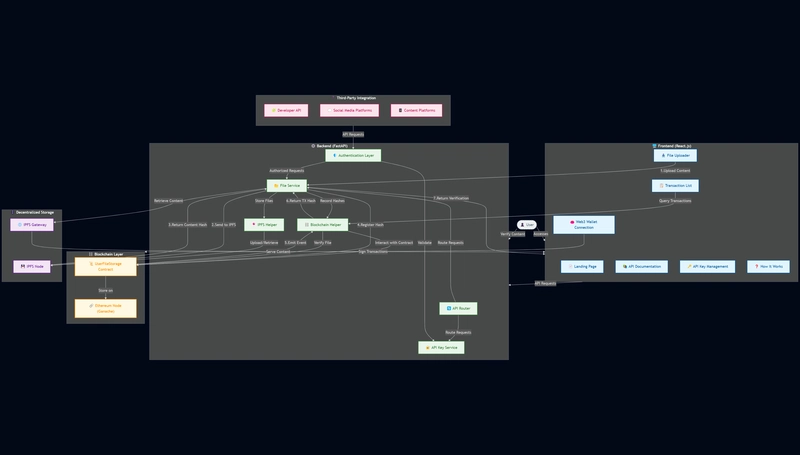
Introduction: The Deepfake Dilemma
In today's digital landscape, the line between authentic and synthetic content is increasingly blurred. Deepfakes and AI-generated media have evolved to a point where distinguishing between real and fabricated content has become nearly impossible for the average person. According to recent studies, deepfake videos online have increased by over 900% since 2019, and this trend shows no signs of slowing down.
As developers and technologists, we face a critical challenge: how do we establish and maintain trust in digital content? How can we provide creators with the tools to prove ownership and authenticity of their work in an age of sophisticated AI manipulation?
This is where the Content Authentication project comes in—a decentralized solution leveraging blockchain technology and distributed storage to establish an immutable record of content provenance.
The Solution: Decentralized Content Authentication
The Content Guard project offers a robust framework for verifying the authenticity of digital content by combining two powerful technologies: blockchain for immutable record-keeping and IPFS (InterPlanetary File System) for decentralized storage.
At its core, the system works by:
- Storing original content on IPFS, generating a unique cryptographic hash
- Recording this hash on the blockchain along with creator information
- Providing verification tools that anyone can use to confirm content authenticity
Unlike centralized authentication systems that rely on a single point of truth (and failure), this decentralized approach distributes trust across the network, making it resistant to tampering and censorship.
Technical Architecture
Let's dive into the technical components that make up the Content Authentication system:
Frontend (React.js with Material-UI)
The frontend provides an intuitive interface for content creators to authenticate their work and for users to verify content. Built with React and Material-UI, it offers:
- Wallet connection using Web3 providers like MetaMask
- File upload interface with drag-and-drop capabilities
- Dashboard to view authenticated content and transaction history
- Verification tools for checking content authenticity
Key components from our frontend codebase include:
// BlockchainFileUploader.jsx
import React, { useState } from 'react';
import { useWeb3React } from '@web3-react/core';
import { uploadFileToIPFS, registerFileOnBlockchain } from '../utils/FileUtils';
const BlockchainFileUploader = () => {
const { account, library } = useWeb3React();
const [uploadStatus, setUploadStatus] = useState('idle');
const handleFileUpload = async (file) => {
try {
setUploadStatus('uploading');
// Upload to IPFS
const ipfsResult = await uploadFileToIPFS(file);
// Register hash on blockchain
const tx = await registerFileOnBlockchain(
ipfsResult.hash,
file.name,
account,
library.getSigner()
);
setUploadStatus('success');
return {
ipfsHash: ipfsResult.hash,
txHash: tx.hash,
};
} catch (error) {
setUploadStatus('error');
console.error('Upload failed:', error);
}
};
// Component rendering code...
}
Backend (FastAPI with Python)
Our backend API handles the bridge between the frontend, blockchain, and IPFS:
@router.post("/upload")
async def upload_file(
file: UploadFile,
file_name: str = Form(...),
user_address: str = Form(...)
):
"""Upload a file to IPFS and store metadata in blockchain."""
try:
user_address = Web3.to_checksum_address(user_address)
result = await save_file_to_ipfs_and_blockchain(file, file_name, user_address)
return JSONResponse(content=result)
except Exception as e:
logger.error(f"Error uploading file: {str(e)}")
raise HTTPException(status_code=500, detail="An error occurred while uploading the file.")
The backend implements several key services:
- IPFS Integration - Handling file storage and retrieval from the distributed file system
- Blockchain Interface - Communicating with Ethereum smart contracts
- Authentication Layer - Securing API endpoints with wallet-based verification
- Transaction Management - Tracking and recording content registration events
Blockchain Layer (Ethereum/Solidity)
The blockchain component provides the immutable ledger for content authentication records. Our Ethereum smart contract handles:
// UserFileStorage.sol
pragma solidity ^0.8.0;
contract UserFileStorage {
struct FileRecord {
string ipfsHash;
string fileName;
uint256 timestamp;
address owner;
bool exists;
}
// Mapping from IPFS hash to file record
mapping(string => FileRecord) private fileRecords;
// Event emitted when a new file is registered
event FileRegistered(string ipfsHash, string fileName, address owner, uint256 timestamp);
/**
* Register a new file with its IPFS hash
*/
function registerFile(string memory _ipfsHash, string memory _fileName) public {
require(bytes(_ipfsHash).length > 0, "IPFS hash cannot be empty");
require(!fileRecords[_ipfsHash].exists, "File already registered");
FileRecord memory newFile = FileRecord({
ipfsHash: _ipfsHash,
fileName: _fileName,
timestamp: block.timestamp,
owner: msg.sender,
exists: true
});
fileRecords[_ipfsHash] = newFile;
emit FileRegistered(_ipfsHash, _fileName, msg.sender, block.timestamp);
}
/**
* Verify if a file exists and get its details
*/
function verifyFile(string memory _ipfsHash) public view returns (
bool exists,
string memory fileName,
address owner,
uint256 timestamp
) {
FileRecord memory record = fileRecords[_ipfsHash];
return (
record.exists,
record.fileName,
record.owner,
record.timestamp
);
}
}
IPFS Integration
IPFS provides content-addressed storage, a perfect fit for content authentication:
# ipfs_helper.py
import io
import aiohttp
from fastapi import UploadFile
from app.core.config import settings
async def upload_to_ipfs(file: UploadFile) -> dict:
"""
Upload a file to IPFS using the Infura API.
Args:
file: The file to upload to IPFS
Returns:
Dictionary with IPFS hash and other metadata
"""
contents = await file.read()
async with aiohttp.ClientSession() as session:
async with session.post(
f"{settings.IPFS_API_URL}/add",
headers={
"Authorization": f"Basic {settings.IPFS_API_AUTH}"
},
data={
'file': (file.filename, io.BytesIO(contents), file.content_type)
}
) as response:
if response.status != 200:
error_text = await response.text()
raise Exception(f"IPFS upload failed: {error_text}")
result = await response.json()
return {
"hash": result["Hash"],
"name": result["Name"],
"size": result["Size"]
}
When content is uploaded to IPFS, the resulting hash serves as both an address and a verification mechanism - any change to the content would produce a different hash, making tampering evident.
Developer Integration
One of the most powerful aspects of the Content Authentication system is its API, designed for seamless integration with social media platforms and content management systems.
API Endpoints for Developers
// Example: Authenticating content from a social media platform
fetch('/api/v1/files/developer/upload', {
method: 'POST',
headers: {
'x-api-key': 'YOUR_API_KEY'
},
body: formData // Contains file, filename, and wallet address
})
.then(response => response.json())
.then(data => {
console.log('Content authenticated:', data);
// Store the IPFS hash and transaction ID with your content
})
.catch(error => console.error('Authentication error:', error));
The developer API provides several key endpoints:
-
/api/v1/files/developer/upload: Authenticate and register new content -
/api/v1/files/developer/transactions: Retrieve transaction history for authenticated content -
/api/v1/files/developer/files-with-urls: Get files with their corresponding IPFS URLs -
/api/v1/files/developer/delete: Remove file metadata (content remains on IPFS due to immutability) -
/api/v1/files/developer/transaction-details: Get detailed information about specific transactions -
/api/v1/files/developer/blockchain-stats: Retrieve statistics about blockchain usage -
/api/v1/files/developer/balance: Check wallet balance for transaction fees -
/api/v1/files/developer/update-metadata: Update metadata without changing the content hash -
/api/v1/files/developer/search: Search for authenticated files by various criteria -
/api/v1/files/developer/recent-transactions: Review recent authentication history
This API makes it easy for platforms to implement "Verified Content" badges or authentication layers without having to build blockchain infrastructure.
User Experience
For end users, the Content Authentication system offers a straightforward experience:
- Connect their Ethereum wallet (like MetaMask)
- Upload content for authentication
- Receive a IPFS QmHash with IPFS link and blockchain transaction ID
- Share content with verification links to prove authenticity
Note : Wallet connection is handled by MetaMask Extension
Content Upload :
Transactions Records with preview:
The system maintains a balance between technical security and user-friendly operation, making content authentication accessible even to creators with limited technical knowledge.
Advantages of Decentralized Storage for Content Authentication
Traditional content authentication systems typically rely on centralized databases that present several challenges:
- Single point of failure: If the authentication service goes down, verification becomes impossible
- Trust requirements: Users must trust the central authority to maintain accurate records
- Potential for manipulation: Records could be altered if the central system is compromised
By contrast, our decentralized approach offers compelling advantages:
- Resistance to censorship: Content stored on IPFS cannot be easily removed or censored
- Tamper-proof records: Blockchain transactions are immutable once confirmed
- Distributed verification: Anyone can verify content without relying on a central service
- Permanence: Content remains accessible even if the original authentication service disappears
- Transparency: The verification process is open and auditable
The Verification Process
The heart of the Content Authentication system is its verification process:
def verify_file_on_blockchain(ipfs_hash: str):
"""
Verify if a file exists on the blockchain.
Args:
ipfs_hash: IPFS hash of the file to verify
Returns:
Boolean indicating if the file exists
"""
try:
verification_status = contract.functions.verifyFile(ipfs_hash).call()
logger.info(f"Verified file with hash {ipfs_hash}, status: {verification_status}")
return verification_status
except Exception as e:
logger.error(f"Error verifying file on blockchain: {str(e)}")
raise
When a user wants to verify content, they can:
- Calculate the IPFS hash of the content in question
- Query the blockchain to check if this hash has been registered
- Compare the registered creator address with the claimed source
Future Plans: AI-Based Synthetic Media Detection
While our current system establishes a strong foundation for content authentication, we recognize the need for proactive detection alongside verification. Our roadmap includes:
- AI-based synthetic media detection: Implementing machine learning models to detect signs of AI manipulation in unregistered content
- Forensic analysis tools: Adding capabilities to identify specific manipulation techniques
- Confidence scoring: Developing a nuanced scoring system that reflects the probability of content authenticity
- Cross-platform verification: Creating browser extensions and mobile apps for instant verification across the web
- Open endpoints for social media: Allowing platforms to automatically verify content authenticity
The combination of blockchain verification with AI detection creates a powerful dual approach to the deepfake problem - establishing provenance for authentic content while providing tools to identify synthetic media.
Get Involved: Try the Playground
We've deployed a working playground where developers can test the Content Authentication system:
- Connect your wallet (test accounts provided for those without Ethereum wallets)
- Upload sample content to see the authentication process in action
- Verify content using the provided tools
- Explore API documentation for integration options
(Note :






































































